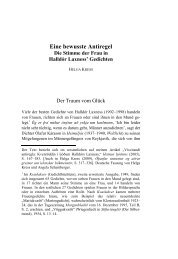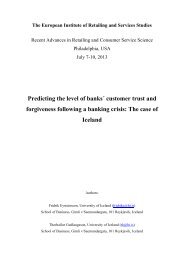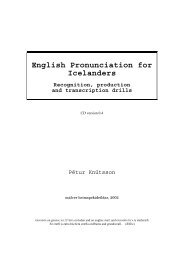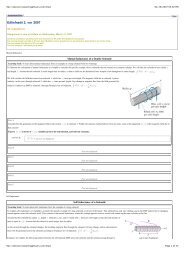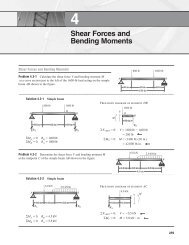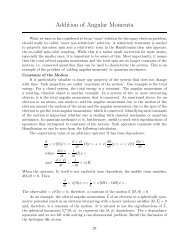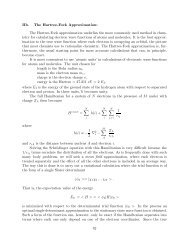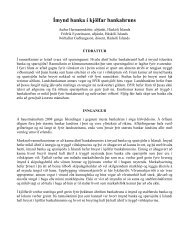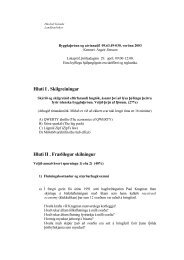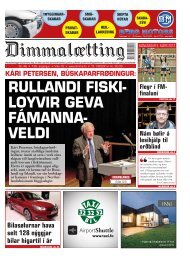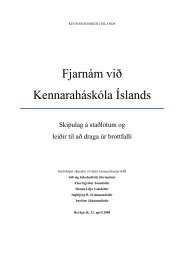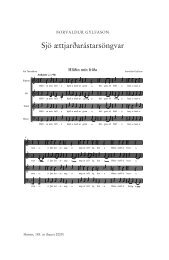Eðlisfræði 2, vor 2007
Eðlisfræði 2, vor 2007
Eðlisfræði 2, vor 2007
Create successful ePaper yourself
Turn your PDF publications into a flip-book with our unique Google optimized e-Paper software.
http://session.masteringphysics.com/myct<br />
04/19/<strong>2007</strong> 05:02 PM<br />
inductors.<br />
Part A<br />
What inductance would be needed to store energy (kilowatt-hours) in a coil carrying current ?<br />
Hint A.1<br />
The formula for the energy stored in a current-carrying inductor<br />
Recall the formula for energy stored in an inductor: .<br />
Part A.2 Express the energy in joules<br />
What is the energy<br />
expressed in joules?<br />
Express your answer numerically, to three significant figures.<br />
ANSWER: = 1.08×10 7 joules<br />
ANSWER: = 240 H<br />
This is probably not the best way to store energy: unless the coil is a superconductor, the amount of heat dissipated in the coil would be enormous. At this point, there is no way to produce<br />
large superconducting coils. Think of this problem as a practice exercise rather than a realistic example.<br />
The L-R Circuit<br />
A Parallel and Series LR Circuit Conceptual Question<br />
In the circuit shown in the figure, the two resistors are identical and the inductor is ideal (i.e., it has no resistance).<br />
Part A<br />
Is the current through greater than, less than, or equal to the current through immediately after the switch is first closed?<br />
Hint A.1<br />
Ideal inductors in circuits<br />
Inductors have time-dependent effects on the behavior of electric circuits. When a potential difference is first applied to an ideal inductor, the inductor generates a back emf equal in magnitude<br />
to the potential difference applied, but opposite in direction. After a long time, the emf generated by the inductor falls to zero and an ideal inductor acts like a simple resistance-free wire.<br />
Hint A.2<br />
Replacing the inductor with an "open"<br />
When the switch is first closed, the inductor generates a back emf equal in magnitude to the potential difference applied. This means that no net potential difference exists across the inductor, so<br />
no current can flow through the inductor. Thus, the inductor acts like an "open" in the circuit. Imagine simply removing the inductor from the circuit, leaving the circuit open at the location<br />
occupied by the inductor. Analyze the remaining circuit using ideas developed earlier.<br />
ANSWER: greater than less than equal to cannot be determined<br />
Part B<br />
Is the current through greater than, less than, or equal to the current through a very long time after the switch is closed?<br />
Hint B.1<br />
Replacing the inductor with a "short"<br />
Long after the switch is closed, the inductor generates no emf and acts like a zero-resistance wire. Thus, the inductor acts like a "short" in the circuit. Imagine simply replacing the inductor with<br />
a bare wire. Analyze the remaining circuit using ideas developed earlier.<br />
ANSWER: greater than less than equal to cannot be determined<br />
Part C<br />
Is the current through greater than, less than, or equal to the current through immediately after the switch is opened (after being closed for a very long time)?<br />
Hint C.1<br />
Current without a battery<br />
By opening the switch, the battery is removed from the circuit. If any current still flows in the circuit, it must be due to electromagnetic induction.<br />
Hint C.2<br />
Inductor as a battery<br />
Since current flows through the inductor before the switch is opened, current will be induced in the inductor immediately after the switch is opened in an "attempt" to oppose the reduction in the<br />
magnetic flux due to the removal of the current. This current will flow from the inductor through any components that form a closed circuit with the inductor.<br />
http://session.masteringphysics.com/myct<br />
Page 4 of 15



